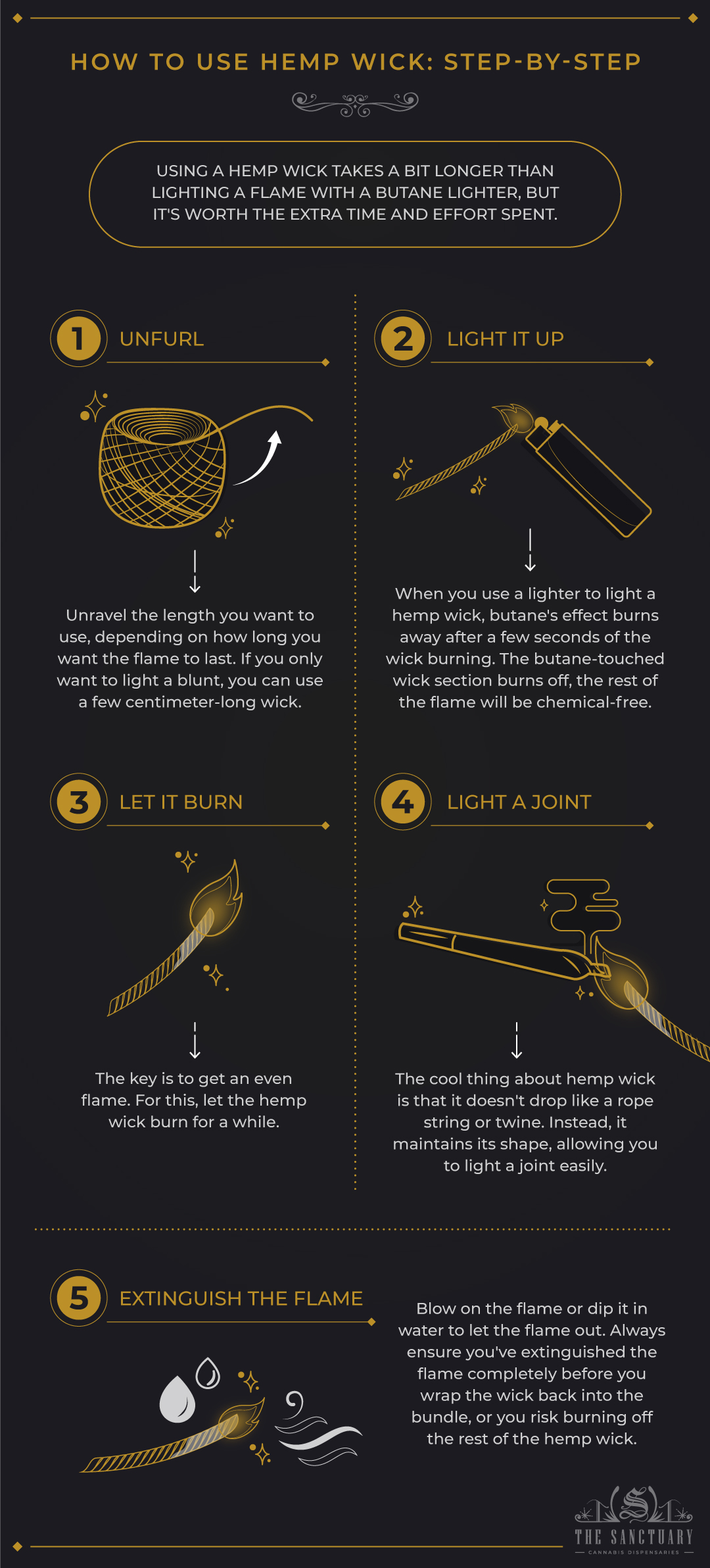Iftikhar Alam
Author
Reviewed by Cannabis Experts
Published on: September 6, 2023 | Updated on: September 11, 2024
Here’s a fun idea: smoke cannabis with cannabis! Let’s decode this a bit. We mean ditching matches and lighters to use hemp wick for lighting up your blunt instead.
Many smokers believe that once you go hemp, you never go back. That’s mainly because hemp wick replaces butane lighters, which expose you to harmful chemicals and hot air.
But before you can use hemp wick for your next smoke sesh, you must know a bit about how and why to use it. We’ve got it all covered in this guide.
What Is Hemp Wick?
Hemp wick is a twine-like string made of hemp fibers. Since pure hemp has a fast combustion rate and burns quickly, beeswax is used to coat hemp wick for a more controlled and slower burning.
When you light it up, the hemp wick burns quite like a candlestick. That makes it ideal for lighting joints, pipes, and bongs alike.
Thickness of Hemp Wick
The thickness of the hemp wick determines its burning speed. Thicker wicks tend to burn slowly, while thinner ones burn fast and have low wind tolerance. Here are some common sizes.
- 0.5mm: At this diameter, the hemp wick has minimal wind tolerance and burns quickly. You can use a hemp wick with this thickness for indoor smoking.
- 1mm: Most commercially-made hemp wicks come in this size. They are suitable for outdoor and indoor use.
- 2mm: Since these wicks have a larger diameter, they burn slowly. If you like to smoke weed out in the open, where the wind can put out matches and other flames, a 2-mm hemp wick will do the trick.
Types of Hemp Wick
When shopping for hemp wicks, you’ll come across the following types:
- Balls: Some hemp wicks are rolled to form large balls. As the tip burns, you slowly use up the whole sphere.
- Cylinders: Hemp wicks also come as cylinders. All you have to do is remove the wick from the packaging instead of opening up a whole ball.
- Thick: These hemp wicks are for outdoor smoking or lighting up large bowls. They have a thicker diameter and a slow burn rate.
- Standard: These hemp wicks have a moderate burn time and a small flame. They’re best for blunts and joints.
- Lighter Sleeve: Think of these as butane lighters, but with hemp wicks instead. The wick protrudes from the sleeve for easy lighting.
Why Use Hemp Wick
To better understand why using hemp wick is a good option, you need first to learn the hazards of butane lighters. We all agree that butane lighters are easy and convenient to use. A press of the finger is all you need to get a flame going.
But this flame burns at a high temperature, which means it has a hotter smoke. Upon inhalation, this smoke goes into your lungs.
However, it’s not alone. It also contains terpenes and cannabinoids that the hot butane burns off the weed. The higher temperature also leads to less potent flavor since the hot gas destroys most of the aroma.
Another downside of butane lighters is the high cost of replacement. On the other hand, if you buy hemp wick in bulk, you will be able to use it for months on end.
Hemp wicks are also more eco-friendly since they only leave ash behind on burning. A butane lighter is made of non-biodegradable plastic that stays in landfill for millions of years.
Here’s what we learn from all of this: hemp wicks are more sustainable, eco-friendly, natural, and economical. They also prevent you from inhaling harmful smoke or a hot gas while preserving the joint’s aroma and flavor.
How to Use Hemp Wick: Step-by-Step

Using a hemp wick takes a bit longer than lighting a flame with a butane lighter, but it’s worth the extra time and effort spent. Follow these steps to light up a hemp wick.
Step 1: Unfurl
If you’ve bought hemp wick furled up in a sphere shape, unfurl it first. Remove the tape keeping the wick from unfurling itself. Do not open the ball too much because it can be hard to reform the shape on your own.
Only unravel the length you want to use, which will depend on how long you want the flame to last. For example, if you only want to light a blunt, you can use a few centimeter-long wick.
Step 2: Light It Up
Yes, we get it. We just said butane lighters are a bad choice in every possible way, but now we’re telling you to light up the hemp wick with a lighter.
When you light a joint with a butane lighter, the gas’s effect lingers. However, when you use the same lighter to light a hemp wick, butane’s effect burns away after a few seconds of the wick burning.
As the butane-touched wick section burns off, the rest of the flame will be chemical-free.
Step 3: Let It Burn
The key is to get an even flame. For this, let the hemp wick burn for a while.
Step 4: Light a Joint
Now, you can use the flame from the hemp wick to light up a joint. The cool thing about hemp wick is that it doesn’t drop like a rope string or twine. Instead, it maintains its shape, allowing you to light a joint easily.
For a bong or pipe, put the burning hemp wick inside the bowl. You can blow it out after a few seconds or let it burn until the flame goes out.
Step 5: Extinguish The Flame
Blow on the flame to extinguish it. You can also dip it in water to let the flame out.
Always ensure you’ve extinguished the flame completely before you wrap the wick back into the bundle, or you risk burning off the rest of the hemp wick.
Conclusion
The method mentioned above would have made it very clear that using a hemp wick isn’t much harder than lighting a match. Most dispensaries stock hemp wicks that you can buy in different shapes and sizes. Choose the one that best suits your needs, and you’re all set.
The content provided on this blog is for informational purposes only and does not constitute medical, legal, or professional advice. Cannabis use is subject to local laws and regulations, which vary widely by jurisdiction. Always consult with a healthcare professional before starting any new treatment or altering an existing treatment regimen. The authors and publishers of this blog are not responsible for any actions taken based on the information provided herein. Use cannabis responsibly and in accordance with applicable laws. This blog is intended for adults aged 21 and over. The Sanctuary Dispensaries D186, D187.








